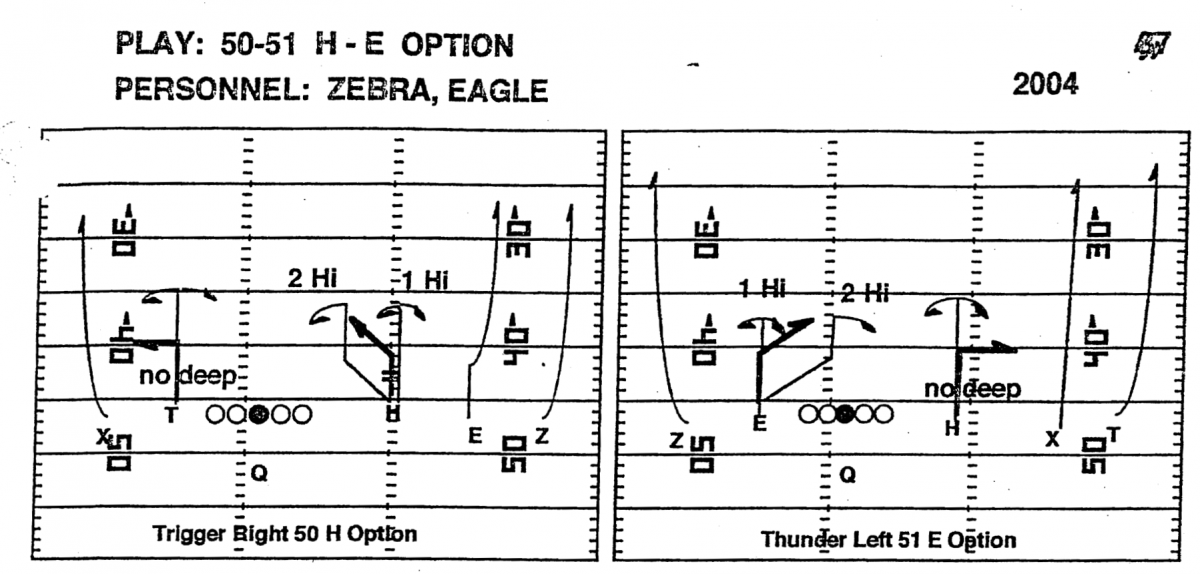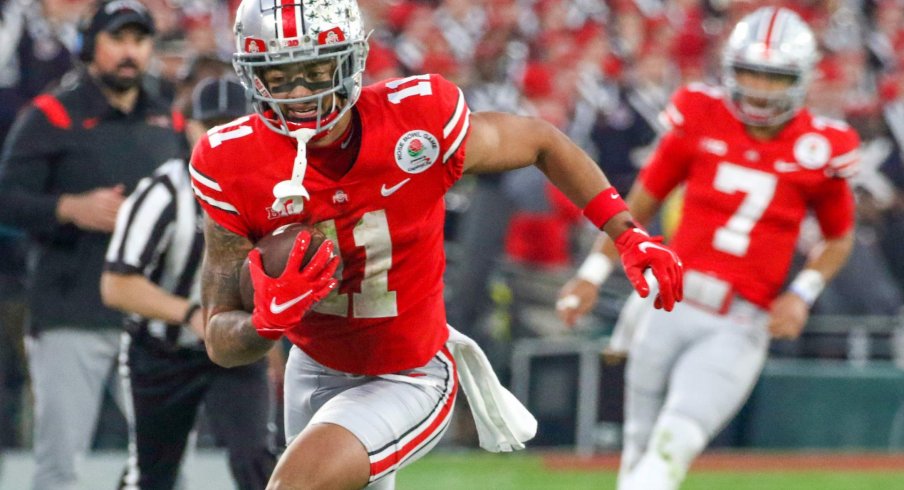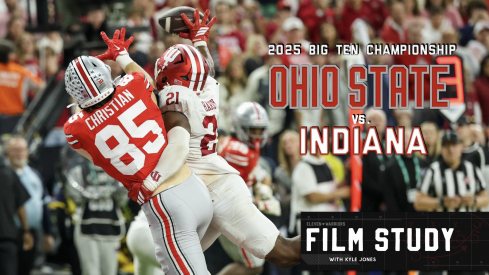"Honestly, I just trust the process, trust that Coach is going to put me in the right opportunity, that C.J. is going to put me in the right opportunity. Just taking advantage of every opportunity that I get." - Jaxon Smith-Njigba
347 receiving yards is a lot. It's 90 more yards than Utah tallied as a team in the Rose Bowl. It's only five yards fewer than Keegan Jacobs, the leading receiver for the Big Ten West champion Iowa Hawkeyes, had throughout the course of the entire season. And, it's obviously more than any Ohio State Buckeye had ever produced in a single game.
So, while I'm sure many of you have questions about what happened with Ohio State's defense in the second half of the Rose Bowl, there's plenty of time to discuss that over the next months. Instead, let's just take a few minutes today and enjoy Jaxon Smith-Njigba's legendary performance in Pasadena:
JAXON SMITH-NJIGBA IS DIFFERENT @OhioStateFB
— PFF College Football (@PFF_College) January 2, 2022
pic.twitter.com/AHmiS6Xepq
"The throw on the touchdown pass, the inside slot fade, the throw, and the catch there are probably as good as I've ever seen in a big-time spot," Ryan Day said of the sophomore's third touchdown catch of the day, echoing the thoughts of pretty much everyone watching.
Though it's easy (and still correct) to simply boil down the play to JSN just being different, as the tweet declares, that masks the hard work that happened behind the scenes. While Kirk Herbstreit may have declared that 'you can't teach' what Smith-Njigba did to haul in that pass, Brian Hartline and Keenan Bailey have certainly tried:
/WIND IT/
— Keenan Bailey (@CoachKee) March 3, 2021
verb.
Positioning the catch of a deep pass outside and in front of your body, to create a Ball-Me-Defender relationship at the catch point.
Check out @TheTerry_25 wind it in a drill, at practice in college, and then in the NFL. #DevelopedHere pic.twitter.com/oXF6vDKhRL
The combination of great talent and great coaching deserves the credit for the record-setting performances of Smith-Njigba and his quarterback, C.J. Stroud, in last Saturday's Rose Bowl game. Without Garrett Wilson and Chris Olave lining up next to him, it quickly became evident that Smith-Njigba was the focal point of Day's game plan to beat the Utes.
That didn't mean just throwing the ball up to him on Go routes every play; there was a method to the madness of throwing him 17 passes, 15 of which were caught. Early on, JSN was featured heavily on screens and designed flares to get him the ball in space, but the Buckeye offense still looked rather flat throughout the first quarter.
Once they began recognizing the patterns in Utah's defensive plan, however, Day and his team were able to attack the weakest points in its secondary. While former Buckeye commit Clark Phillips III played a whale of a game himself as the Utes' left corner, allowing just 5 catches for 38 yards on 9 passes thrown his way, Smith-Njigba often lined up away from him throughout much of the game.
Though a slot receiver by trade, he would line up as an outside receiver when Ohio State went with two tight ends, removing the slot. This meant that he was often matched up one-on-one with converted running back Micah Bernard in such situations.
While the Buckeyes intended to run the ball from these heavier formations, they also built in a pre-snap read for Stroud to check the coverage of the corner outside against his star receiver, as the duo were effectively alone out by the numbers on the opposite side of the field. Without a safety rolling over to help, Stroud knew Smith-Njigba would be open on a 'glance' concept, where the receiver just takes the open space given to him, either on a slant inside or releasing on a fade outside.

When Bernard closed down hard inside to take away the slant and keep an eye on what was happening in the backfield, it gave Smith-Njigba plenty of room to break outside and streak down the sideline on a fade route. As the rest of the Buckeyes executed a run play going the other way, Stroud pulled the ball away from his running back and dropped in a perfectly thrown ball that gave his target the chance to run after the catch, directly into the end zone.
These run-pass options (RPOs) were a consistent part of Day's game plan throughout the afternoon. While some fans will decry the imbalance between the run and the pass, never shedding the run-first attitude ingrained by Woody Hayes or Jim Tressel, this was not by design. Stroud simply threw when the Utes played the run too aggressively.
"I thought we did have a good mix of run and pass," Day said after the game, anticipating the criticism of a fanbase that is never satisfied. "Some of the stuff that will show up on the stat sheet as passes are run-pass options, whether they're bubbles or throws down the field. I thought C.J. did an excellent job of executing in those spots."
Not all of Stroud's reads were before the snap, either. With All-American linebacker Devin Lloyd sitting in the middle of the field, the Buckeyes looked to give him false cues to move him out of the way and open up windows into which Stroud could throw underneath.
For example, watch as the Buckeyes actually ran three plays in one in the clip below:
While TreVeyon Henderson and the offensive line executed a Mid Zone run into the boundary, Julian Fleming ran a bubble screen in the same direction. That action was enough to make Lloyd shuffle toward it, leaving a wide-open window in the middle of the field, into which Smith-Njigba ran a slant route that led to big yardage after the catch.
Moving Lloyd out of the way to create space for Smith-Njigba between the hashes was a constant focus for Day as a play-caller, with many of his tactics easy to overlook.
Utah employed more two-deep zone looks on early downs when Ohio State was in the shotgun, with Lloyd sitting right in the middle of the coverage. Though the Buckeyes liked to align in 2x2 formations, they would release the running back out to the tight end side, leading Lloyd to drift that way, given that the back became the third receiver in that route combination.
However, that meant that Lloyd was drifting away from where Smith-Njigba was running in between the zones of the nickelback and safety, leaving an open window right in the middle of the field.
But as talented as Lloyd and fellow 'backer Nephi Sewell may be, Day knew that they stood no chance when forced to match up with his star slot man. In order to ensure that JSN would be picked up by the linebackers, Day went as far as to line him up in the backfield in place of the running back before releasing downfield, leaving Lloyd and Sewell in the dust.
Though Smith-Njigba was the centerpiece of the OSU game plan, he wasn't the entirety of it. The Buckeyes struggled to move the ball on the ground in the first half as the Utes created problems along the line of scrimmage.
All season long, the Buckeyes preferred to run the ball best from pistol looks with Henderson lined up directly behind Stroud. However, opponents had picked up on this tendency and sold out to stop the run whenever Ohio State lined up this way. One way Utah exploited it was by 'stemming' the defensive tackles, meaning they would bump over one gap just before the ball was snapped, creating confusion for Ohio State's offensive linemen.
After halftime, however, the Buckeyes abandoned the pistol altogether and moved Stroud under center more often. With the QB in that position, he could alter the snap count more easily with his voice, rather than relying on a hand clap or other signal to snap the ball. This meant that the Utes had trouble timing up their pre-snap movement, meaning they often weren't set properly as the ball was snapped.
Additionally, this move under center meant OSU would see more man coverage, especially when two tight ends were in the game. Utah clearly expected Ohio State to run from these alignments and responded by playing man-free (Cover 1) to bring safety Cole Bishop into the box, allowing JSN plenty of room to run in the space vacated by defenders who bought the play-action fake.
All these minor adjustments allowed the Buckeyes to fight back and ultimately tie the game in the fourth quarter. When Ohio State absolutely needed to move the ball, however, they looked back to #11.
On a critical fourth down late in the game, the Buckeyes went with an empty formation, splitting out Smith-Njigba in the slot on the weak side. As the outside receiver to that side released straight downfield, it meant Sewell, the weakside linebacker, was responsible for defending Smith-Njigba underneath as the Utes played Quarters coverage in the secondary.
What came next was something Utah head coach Kyle Wittingham knows all too well, given that he was the defensive coordinator for Urban Meyer in Salt Lake City during 2003 and 2004, taking over the program when Meyer left for the University of Florida. At the time, one of Meyer's favorite pass plays was known as H-option, in which the slot receiver runs an 8-10 yard route straight downfield before breaking inside or outside, depending on the coverage.

One of the keys to Smith-Njigba's elite route-running is his ability to change speeds, both when running in a straight line and while coming in and out of breaks. Both were on display as he executed this concept perfectly.
Watch as he appears to explode downfield after a few stutter steps at the line, causing Sewell to panic and try to slow him down by making contact. But JSN was hoping to get Sewell to do such a thing, knowing he'd immediately cut back outside before the slower defender could land a clean hit, leaving the receiver wide open and Sewell grasping at air.
Many veteran NFL receivers would be unable to run such a route so perfectly, yet here is Smith-Njigba, just a sophomore and with the Rose Bowl on the line, making it look effortless. It's no wonder that Pro Football Focus gave him the third-highest receiving grade of any player at the position this season, trailing only a pair of receivers from the service academies who saw a mere fraction of Smith-Njigba's targets.
His PFF grade of 92.0 surpassed that of Biletnikoff winner Jordan Addison of Pitt (88.3), finalists David Bell of Purdue (86.9), and Jameson Williams of Alabama (84.4). In a year where the NFL draft class of wideouts is considered to be exceptionally deep, Smith-Njigba also outperformed anticipated first-rounders like USC's Drake London (91.8), OSU teammates Garrett Wilson (84.5) and Chris Olave (79.9), Arkansas' Treylon Burks (90.8) and Penn State's Jahan Dotson (87.2).
While Stroud is already considered a Heisman front-runner next season after finishing fourth in the balloting this past fall, Smith-Njigba has cemented his own place in the conversation as well, thanks in large part to his performance on one of the sport's biggest stages.
"Certainly, some of the plays he made tonight were tremendous. We leaned on him a lot," Day said after the game. "At one point I asked him, are you tired? On the play there where Clark caught him, he looked at me like what are you asking me for? Are you crazy? I'm going back out there. And played one of the best games probably in the history of the Rose Bowl."



